How To Remove Data From Dataframe In R
Drop rows in R with weather can exist washed with the assistance of subset () part. Permit'due south run across how to delete or drop rows with multiple conditions in R with an example. Drop rows with missing and null values is accomplished using omit(), complete.cases() and slice() function. Drop rows by row index (row number) and row name in R
- drop rows with status in R using subset function
- driblet rows with null values or missing values using omit(), consummate.cases() in R
- drop rows with slice() role in R dplyr package
- drib duplicate rows in R using dplyr using unique() and singled-out() role
- drib rows based on row number i.eastward. row index in R
- drib rows based on row proper name in R
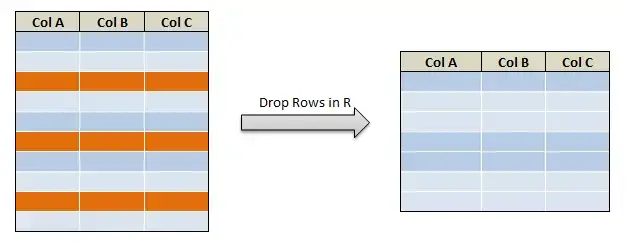
Let's first create the dataframe.
# create dataframe df1 = information.frame(Name = c('George','Andrea', 'Micheal','Maggie','Ravi','Xien','Jalpa'), Grade_score=c(4,6,two,9,v,7,8), Mathematics1_score=c(45,78,44,89,66,49,72), Science_score=c(56,52,45,88,33,90,47)) df1 So the resultant dataframe volition be

Delete or Drop rows in R with conditions:
Method i:
Delete rows with proper name equally George or Andrea
df2<-df1[!(df1$Name=="George" | df1$Proper noun=="Andrea"),] df2
Resultant dataframe will be

Method ii: drop rows using subset() role
Drib rows with conditions in R using subset role.
df2<-subset(df1, Name!="George" & Name!="Andrea") df2
Resultant dataframe will be

Method iii: using slice() function in dplyr packet of R
Drop rows with conditions in R using slice() function.
### Drop rows using slice() function in R library(dplyr) df2 <- df1 %>% piece(-c(two, 4, 6)) df2
Resultant dataframe with 2d, 4th and 6th rows removed as shown below

Drop Rows by row proper name and Row number (Row index) in R:

Drop Row by row number or row index:
Drop Rows past row number or Row index in R tin can be accomplished either past slice() office and also past the '-' operator.
### Drib rows using slice() role in R library(dplyr) df2 <- df1 %>% slice(-c(2, iv, 6)) df2
OR
### Drib rows using "-" operator in R df2 <- df1[-c(2, iv, 6), ] df2
Resultant dataframe with second, 4th and 6th rows removed as shown below

Drib Row by row name :
Drop Rows past row name or Row index in R can be accomplished either by slice() function and besides past the '-' operator.
### Drop rows using slice() function in R library(dplyr) df1[!(row.names(df1) %in% c('1','2')), ] Row names are nil just row index numbers in this case

Driblet rows with missing values in R (Drop NA, Drop NaN) :
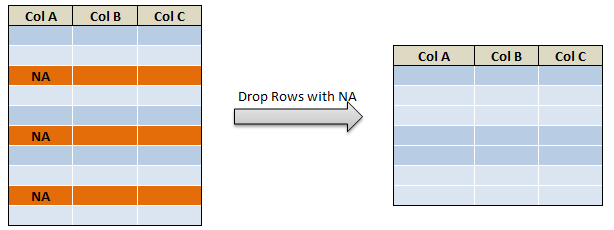
Let's showtime create the dataframe with NA values as shown below
df1 = data.frame(Proper name = c('George','Andrea', 'Micheal','Maggie','Ravi','Xien','Jalpa',''), Mathematics_score=c(45,78,44,89,66,NaN,72,87), Science_score=c(56,52,NA,88,33,xc,47,76)) df1 dataframe will be
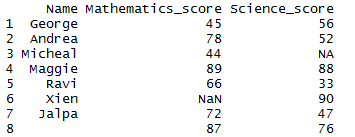
Method i: Remove or Drop rows with NA using omit() function:
Using na.omit() to remove (missing) NA and NaN values
df1_complete = na.omit(df1) # Method one - Remove NA df1_complete
so subsequently removing NA and NaN the resultant dataframe will exist

Method 2: Remove or Drop rows with NA using consummate.cases() role
Using complete.cases() to remove (missing) NA and NaN values
df1[complete.cases(df1),]
and then after removing NA and NaN the resultant dataframe will be

Removing Both Null and missing:
By subsetting each column with non NAs and not null is round nearly manner to remove both Null and missing values as shown below
# Remove null & NA values df1[!(is.na(df1$Name) | df1$Name=="" | is.na(df1$Science_score) | df1$Science_score==""|is.na(df1$Mathematics_score) | df1$Mathematics_score==""),]
so later removing Null, NA and NaN the resultant dataframe will exist

Drib Indistinguishable row in R :
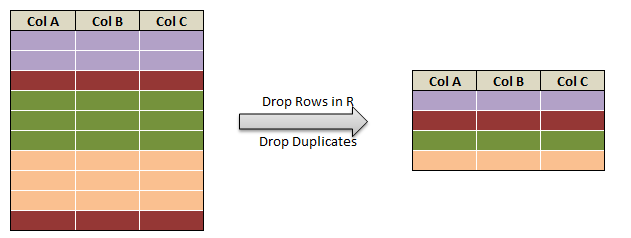
Nosotros will be using the following dataframe to depict the drib duplicates in R. Lets outset create the dataframe.
# elementary Information frame creation mydata = information.frame (NAME =c ('Alisa','Bobby','jodha','jack','raghu','Cathrine', 'Alisa','Bobby','kumar','Alisa','jack','Cathrine'), Age = c (26,24,26,22,23,24,26,24,22,26,22,25), Score =c(85,63,55,74,31,77,85,63,42,85,74,78)) mydata so the resultant information frame will exist
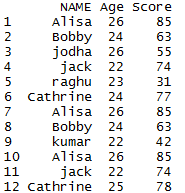
distinct() Function in Dplyr – Remove indistinguishable rows of a dataframe in R:
library(dplyr) # Remove duplicate rows of the dataframe singled-out(mydata)
In this dataset, all the indistinguishable rows are eliminated so information technology returns the unique rows in mydata.
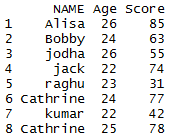
Driblet Duplicates in R using unique() part in R
When nosotros apply unique function to the above data frame
## Utilize unique function for data frame in R unique(mydata)
Indistinguishable entries in the data frame are eliminated and the concluding output volition exist
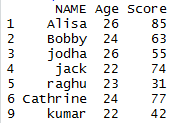
Remove Duplicates based on a cavalcade using duplicated() function
duplicated() function along with [!] takes upward the column name equally argument and results in identifying unique value of the particular column equally shown beneath
## unique value of the column in R dataframe mydata[!duplicated(mydata$NAME), ]
so the dataframe with unique values of the NAME cavalcade will be
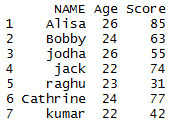
Other Related Topics:
![]()
![]()
How To Remove Data From Dataframe In R,
Source: https://www.datasciencemadesimple.com/delete-or-drop-rows-in-r-with-conditions-2/
Posted by: moodybeftedind1982.blogspot.com


0 Response to "How To Remove Data From Dataframe In R"
Post a Comment